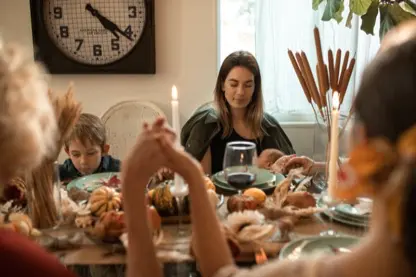How to Have a Successful Blended Family Thanksgiving
Greta Jenkins, Ed.D.

Rather, there is a higher-than-average chance that emotional challenge will make this Thanksgiving meal memorable for all the wrong reasons. Celebrating a happy Thanksgiving can be quite an effort on your part -- but it is well worth it.
Remember That You Are the Norm
According to Pew Research, less than half of the children in the U.S . live in a traditional two-parent family, and the other over 50% are mainly living in single-parent families or blended families. And those single-parent families are often “blended” for at least part of the time.
A sad but true fact is that over 50% of second/third marriages that end in divorce list that it was caused by the children. Children have a strong influence on family dynamics, especially during the Holidays -- both Thanksgiving and Christmas can be a time for stress and strife.
Why blending Families is difficult - Kids Can’t ‘Just’ Fit In
Children often feel they are betraying loyalty, and fear betraying a biological parent’s allegiance when interacting with step-parents and half-siblings. Getting to know new family members can be difficult and there are many new family dynamics to adapt to. Competition between half-siblings is common. And last but not least, Thanksgiving traditions and customs are different, and beloved activities may go by the wayside in a new family.
Recognize that your relationship is with your partner and not the children
Don’t expect children to just be on board or just go along. And if your partner is a serial marriage or relationship partner, there is even less of a chance that the children might willingly give their hearts.
So What’s the Step Parent To Do At Thanksgiving?
Give respect to Get Respect.
Treat stepchildren the way you want to be treated. If you want respect, treat the children -- regardless of age with respect. Model the desired behavior. Don’t expect instant reciprocal behavior; after all you're in for the long haul. Be a good role model-- no matter what.
Be comfortable in your role.
You will never be the new mom or dad. The kids already have one. Do not demand to be called “mom” or “dad;” do not refer to the bio-parent as “real mom” or “other mom.” A step-parent has a different rank in the family hierarchy than a parent; do not try to acquire a seat of honor that is not yours to occupy.
Instead, carve out your role of step-parent as a positive influence on -- and provider of care to -- the children.
Become unified with your spouse.
Present the kids with a united front when it comes to acceptable and unacceptable behaviors, consequences, and expectations.
Start new traditions.
Do not try to compete with the bio-parent at Thanksgiving. Whether you are in a custodial or non-custodial position, remember that the old traditions mean a lot to the kids. Start your own, so as to differentiate your home from the other parent’s residence. There is no need to one-up the mom or dad.
Respect the other parent.
Go out of your way to defer to the other parent. Children will feel more comfortable with you if they realize that liking you will not in any way affect their loyalty to their mom or dad.
Do not expect a perfect happy family
You knew ahead of time that you were entering into a blended family situation. Do not (now) bemoan the unfairness of having to hold up your plans and dreams to accommodate a court-ordered visitation schedule. Do not rebel when the children fail to sit at the table with bright eyes that gaze adoringly at you as you present the turkey. This is rarely the case for nuclear families and is made more difficult for blended families, where intense likes and dislikes create an emotional undertow.
It is possible to successfully make it through the holiday season in general and Thanksgiving in particular Just remember: a parent’s ( bio’s step…) love was meant to be shared and freely given away
Greta Jenkins Ed.D.
Greta is an educational psychologist, parenting expert, artist and author of “Do siblings influence one another? More about Greta Jenkins